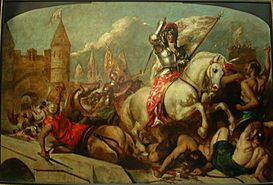Triptych facts for kids
A triptych is a special kind of artwork made of three separate pictures. These pictures are usually paintings, but they can also be carvings or other art forms. They are designed to be seen together, telling a story or showing different parts of one idea.
The word "triptych" comes from ancient Greek words. "Tri" means three, and "ptysso" means to fold. This is because triptychs often have hinges. These hinges let the side panels fold inwards, covering the middle one. The middle painting is often the biggest, but sometimes all three parts are the same size. While usually art, anything made of three parts that fit together can be called a triptych.
Famous Triptychs in Art
Triptychs have been popular for hundreds of years, especially in churches. They were often used as altarpieces, which are artworks placed on or behind an altar. Many famous artists have created triptychs.
William Etty's Joan of Arc Triptych
A well-known example is a large triptych by the English painter William Etty. He created a huge artwork about the life of Joan of Arc, a famous French hero. This painting was very big, about 28 feet (8.5 meters) wide.
After Etty sold it, the three parts of the painting were separated. One part showed Joan of Arc finding a special sword. Another part, which showed Joan fighting, is now in a museum in France. Sadly, the third part of this triptych has been lost over time.
Images for kids
-
The Merode Altarpiece, attributed to the workshop of Robert Campin, c. 1427–32
-
The Aino Myth, the Kalevala based triptych painted by Akseli Gallen-Kallela in 1891. Ateneum, Helsinki
-
Wooden model to the silver triptych of Saint Stanislaus, ca. 1512, National Museum in Warsaw
-
Master of Frankfurt, Sagrada Familia con ángel músico, Santa Catalina de Alejandría, Santa Bárbara, 1510–1520, Museo del Prado, Madrid
See also
 In Spanish: Tríptico para niños
In Spanish: Tríptico para niños








